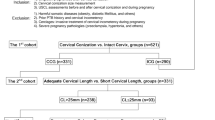Abstract
Objective:
To study the relationship between body mass index (BMI) and gestational age (GA) at delivery in patients with cervical insufficiency (CI) undergoing cerclage.
Study Design:
We accessed a database of patients with singleton gestations undergoing cerclage (N=168) for a well-characterized history of CI, shortened cervix <2.5 cm with a history of prior preterm delivery or prolapse of membranes through the external os. Univariate and multivariate logistic regression analysis were performed to compare obstetrical outcomes between obese and normal-weight patients.
Result:
Prior preterm delivery <35 weeks in obese vs normal-weight patients was significantly higher (44% vs 9%), odds ratio=6.9 (95% CI: 2.5, 18.5), with lower mean GA at delivery (32.6±7.0 vs 37.2±3.4 weeks, P<0.001). After controlling for confounders, BMI remained significantly predictive of prematurity (coefficient: −0.12, adjusted R2=0.24), such that every additional 1 unit of BMI was associated with a 1-day reduction in GA at delivery (P=0.03).
Conclusion:
An inverse correlation exists between BMI and GA at delivery in patients with CI receiving cerclage. The findings are unexpected given the protective effect of obesity on spontaneous preterm delivery.
This is a preview of subscription content, access via your institution
Access options
Subscribe to this journal
Receive 12 print issues and online access
$259.00 per year
only $21.58 per issue
Buy this article
- Purchase on Springer Link
- Instant access to full article PDF
Prices may be subject to local taxes which are calculated during checkout
Similar content being viewed by others
References
Lu GC, Rouse DJ, DuBard M, Cliver S, Kimberlin D, Hauth JC . The effect of the increasing prevalence of maternal obesity on perinatal morbidity. Am J Obstet Gynecol 2001; 185: 845–849.
Robinson HE, O’Connell CM, Joseph KS, McLeod NL . Maternal outcomes in pregnancies complicated by obesity. Obstet Gynecol 2005; 106: 1357–1364.
Ehrenberg HM, Dierker L, Milluzzi C, Mercer BM . Prevalence of maternal obesity in an urban center. Am J Obstet Gynecol 2002; 187: 1189–1193.
Handler I . The Preterm Prediction Study: association between maternal body mass index and spontaneous and indicated preterm birth. Am J Obstet Gynecol 2005; 193: 2178–2179.
Smith G, Shah I, Pell JP, Crossley JA, Dobbie R . Maternal obesity in early pregnancy and risk of spontaneous and elective preterm deliveries: a retrospective cohort study. Am J Pub Health 2007; 97: 157–162.
McDonald SD, Han Z, Mulla S, Beyene J . Overweight and obesity in mothers and risk of preterm birth and low birth weight infants: systematic review and meta-analyses. BJOG 2010; 341: 1–20.
Nohr EA, Bech BH, Vaeth M, Rasmussen K, Henriksen KM, Olsen J . Obesity, gestational weight gain, and preterm birth: a study within the Danish National Birth Cohort. Paediatr Perinatal Epidemiol 2007; 211: 5–14.
Ludmir J, Sehdev HM . Anatomy and physiology of the uterine cervix. Clin Obstet Gynecol 2000; 43: 433–439.
Shennan A, Jones B . The cervix and prematurity: aetiology, prediction, and prevention. Semin Fetal Neonatal Med 2004; 9: 471–479.
MRC/RCOG Working Party on Cervical Cerclage. Final report of the Medical Research Council/Royal College of Obstetrician and Gynecologists multicenter randomized trial of cervical cerclage. Brit J Obstet Gynecol 1993; 100: 516–523.
Berghella V, Obdio AO, To MS, Rust OA, Althuisius SM . Cerclage for short cervix on ultrasonography: meta-analysis of trials using individual patient-level data. Obstet Gynecol 2005; 106: 181–189.
Althuisius SM, Dekker GA, Hummel P, van Geijn HP . Cervical incompetence prevention randomized cerclage trial: emergency cerclage with bed rest versus bed rest alone. Cervical incompetence prevention randomized cerclage trial. Am J Obstet Gynecol 2003; 189: 907–910.
Rafii A, Samain E, Levardon M, Darai E, Deval B . Vaginal hysterectomy for benign disorders in obese women: a prospective study. BJOG 2005; 111: 223–227.
Isik-Akbay E, Harmanli O, Panganamamula U, Akbay M, Gaugham J, Chatwani A . Hysterectomy in obese women: a comparison of abdominal and vaginal routes. Obstet Gynecol 2004; 104: 710–714.
Shen CC, Hsu TY, Huang Fj, Huang EY, Huang HW, Huang HY et al. Laparoscopic-assisted vaginal hysterectomy in women of all weight and the effects of weight on complications. J Am Assoc Gynecol Laparosc 2002; 9: 468–473.
Frezza EE, Shebani KO, Robertson J, Wachtel MS . Morbid obesity causes chronic increase of intraabdominal pressure. Dig Dis Sci 2007; 52 (4): 1038–1041.
Pratt JH, Daikoku NH . Obesity and vaginal hysterectomy. J Reprod Med 1990; 35: 945–949.
Rafii A, Dari E, Haab F, Samain E, Levardon M, Deval B . Body mass index and outcome of tension-free tape. J Eur Urol 2003; 43: 288–292.
Skriapas K, Poulakis V, Dillenburg W, Vries R, Witzsch U, Melekos M et al. Tension-free vaginal tape in morbidly obese patients with severe urodynamic stress incontinence as last option treatment. J Eur Urol 2006; 49: 544–550.
Author information
Authors and Affiliations
Corresponding author
Ethics declarations
Competing interests
The authors declare no conflict of interest.
Additional information
This paper was presented as a poster (Abstract #342) at the 27th Annual Meeting of the Society for Maternal Fetal Medicine.
Rights and permissions
About this article
Cite this article
Poggi, S., Vyas, N., Pezzullo, J. et al. Does increasing body mass index affect cerclage efficacy?. J Perinatol 32, 777–779 (2012). https://doi.org/10.1038/jp.2011.198
Received:
Revised:
Accepted:
Published:
Issue Date:
DOI: https://doi.org/10.1038/jp.2011.198
Keywords
This article is cited by
-
Recurrence rates after abdominal and vaginal cerclages in women with cervical insufficiency: a validated cohort study
Archives of Gynecology and Obstetrics (2017)



